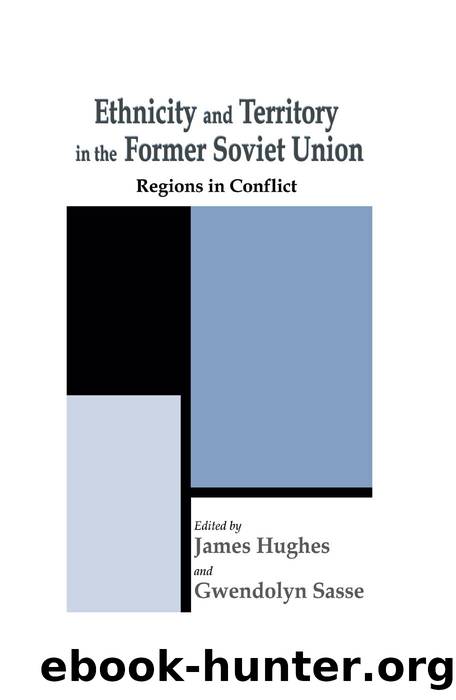Ethnicity and Territory in the Former Soviet Union: Regions in Conflict by unknow

Author:unknow
Language: eng
Format: epub
Tags: Political Science, International Relations, General
ISBN: 9780714652269
Google: 7vjb-0eZ-wcC
Goodreads: 9211208
Publisher: Routledge
Published: 1999-06-01T00:00:00+00:00
Ajaria and the Ajars
The region known as Ajaria is located in the south-western part of Georgia. Its western border is the coastline of the Black Sea, to the south is Turkey, and to the east and north lies the rest of Georgia proper. The jurisdiction of Ajaria passed from the Ottoman to the Russian Empire to Turkey to Georgia, then finally to the Soviet Union. Ajariaâs importance as a region can be traced to the latter part of the nineteenth century when Russia developed the capital Batumi, which became the third largest city in the province of Transcaucasia. As an important strategic and economic port and industrial centre, Batumi provided international rail and sea access, and oil pipelines were later constructed to Baku (Akiner, 1986: 243). In 1922 Ajaria became an ASSR subordinate to the Republic of Transcaucasia. In 1936 it was subordinated to Georgia, when Georgia achieved full Union Republic status separate from Armenia and Azerbaijan. The Ajarian ASSR was an anomalous entity of the USSR. Whereas most of the autonomous entities were established on the basis of language or nationality, Ajaria was afforded autonomous status on the basis of religion.12
As mentioned above, the Ajars of Georgia were not considered a national minority for most of the Soviet period. Rather Ajars are considered to be ethnic Georgians, although they profess Islam as their faith. Conversion to Islam occurred during Ottoman rule from the sixteenth to the late nineteenth century. Ajars remain committed to Islam and there are few interfaith â Islamic-Christian â marriages (Bennigsen and Wimbush, 1986: 208). In the 1926 census, the Ajars were provided with their own national category, which distinguished them from the Georgians. This category was dissolved for the 1939 census, despite the fact that some continued to identify themselves as distinct from Georgians more broadly.13 During this early Soviet period, Islam in Ajaria was severely repressed with mosques and religious schools closed and Islamic names georgianized. Derlugian called it âa time of calamitous ethnic homogenizationâ that, for the most part, seemed to have succeeded (Derlugian, 1995: 33â5). As a consequence of the georgianization policies most Ajars were assimilated and came to recognize themselves as Georgians.
Because the census category for Ajars ended in 1926, it is difficult to estimate the number of Ajars. The 1989 census indicates that the Ajar Republic contained a total population of 381,000. Of this population, âGeorgiansâ constituted 317,000. The number of Ajars, or Muslim Georgians, in this last figure has been estimated to be around 130,000â160,000, or 34â42% of the regional population (Bennigsen and Wimbush, 1986: 208). Consistent with the non-migratory patterns of other Georgians, the total number of Ajars living outside Ajaria is very small.14 In terms of national histories the Ajar-Georgian relationship is complicated because most Ajars today see themselves as Georgian. Georgians, in contrast, are reluctant to accept Ajars as belonging to the wider âGeorgianâ identity due to religious differences. For most Georgians, Georgian means being Christian. The Ajars are Muslim and are, therefore, not considered ârealâ Georgians.
Download
This site does not store any files on its server. We only index and link to content provided by other sites. Please contact the content providers to delete copyright contents if any and email us, we'll remove relevant links or contents immediately.
| Anarchism | Communism & Socialism |
| Conservatism & Liberalism | Democracy |
| Fascism | Libertarianism |
| Nationalism | Radicalism |
| Utopian |
The Secret History by Donna Tartt(18951)
The Social Justice Warrior Handbook by Lisa De Pasquale(12170)
Thirteen Reasons Why by Jay Asher(8849)
This Is How You Lose Her by Junot Diaz(6837)
Weapons of Math Destruction by Cathy O'Neil(6221)
Zero to One by Peter Thiel(5736)
Beartown by Fredrik Backman(5683)
The Myth of the Strong Leader by Archie Brown(5463)
The Fire Next Time by James Baldwin(5387)
How Democracies Die by Steven Levitsky & Daniel Ziblatt(5175)
Promise Me, Dad by Joe Biden(5117)
Stone's Rules by Roger Stone(5055)
A Higher Loyalty: Truth, Lies, and Leadership by James Comey(4909)
100 Deadly Skills by Clint Emerson(4883)
Rise and Kill First by Ronen Bergman(4741)
Secrecy World by Jake Bernstein(4703)
The David Icke Guide to the Global Conspiracy (and how to end it) by David Icke(4659)
The Farm by Tom Rob Smith(4468)
The Doomsday Machine by Daniel Ellsberg(4452)
